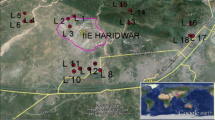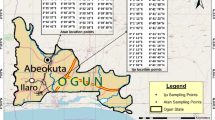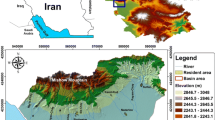Abstract
The study focused on analyzing concentrations of metal(loid)s, their geospatial distribution in groundwater around an industrial hub of northern India. Human health risk posed due to the intake of contaminated groundwater was also evaluated. For this, 240 samples were assayed using inductively coupled plasma emission spectrophotometer. For risk assessment, the methodology proposed by US Environmental Protection Agency was adopted. Geometric mean of Al, As, Mo, Cd, Co, Cr, Fe, Mn, Ni, Pb, Se, and Zn was 193.13, 27.35, 4.22, 2.85, 92.81, 14.97, 271.78, 25.76, 54.75, 19.50, 16.94, and 1830.27 μg/l, respectively. Levels of Al (84%), As (63%), Ni (63%), Pb (49%), and Se (41%) exceeded the Bureau of Indian Standards (BIS). Principal component analysis is accounted for ~ 88% of the total variance and reflected pollution loads of Al, As, Mo, Cr, Fe, Se, and Pb in the groundwater. Based on it, four sources of metal(loid)s, namely geogenic (34.55%), mixed (industrial and agricultural, 26.76%), waste dumping (15.31%), and industrial (11.25%) were identified. Semi-variogram mapping model demonstrated significant geospatial variations of the metal(loid)s. Hazard index (HI) suggested potential non-carcinogenic risks to the inhabitants due to As, Al, Ni, Se, and Pb, which were the largest contributors. Based on maximum concentrations of metal(loid)s, HI for child and adult was above unity. Arsenic was identified as the most hazardous pollutant that may have chronic carcinogenic health implications. At western side of study area, carcinogenic health risks exceeded critical threshold of 1 × 10−4, indicating that As posed health risks to residents by intake of groundwater.






Similar content being viewed by others
References
APHA (American Public Health Association). (2011). Standard methods for examination of water and wastewater (20th ed.). Washington: American Public Health Association.
Bajaj, M., Eiche, E., Neumann, T., Winter, J., & Gallert, C. (2011). Hazardous concentration of selenium in soil and groundwater in North-West India. Journal of Hazardous Materials, 189(3), 640–646. https://doi.org/10.1016/j.jhazmat.2011.01.086.
Bhardwaj, V., & Singh, D. S. (2011). Surface and groundwater quality characterization of Deoria District, Ganga plain, India. Environmental Earth Sciences, 63, 383–395. https://doi.org/10.1007/s12665-010-0709-x.
BIS (Bureau of Indian Standards). (2012). Drinking water specifications, IS: 10500, 2nd revision. New Delhi. http://law.resource.org/ in/bis/S06/is.10500.2012.pdf. Accessed on 12 May 2017.
CGWB (Central Ground Water Board). (2013). Ground water information booklet of Sirmaur District, Himachal Pradesh, Ministry of Water Resources, Govt. of India. 1–23. http://www.cgwb.gov.in/District_Profile/HP/Sirmaur.pdf Accessed on 27 June 2017.
Chabukdhara, M., Kumar, S., Kotecha, Y., & Nema, A. K. (2017). Groundwater quality in Ghaziabad district, Uttar Pradesh, India: multivariate and health risk assessment. Chemosphere, 179, 167–178. https://doi.org/10.1016/j.chemosphere.2017.03.086.
Chapman, D. (1996). Water quality assessments—a guide to use of biota, sediments and water in environmental monitoring. Cambridge ISBN 2:609: University Press. https://doi.org/10.4324/9780203476710.
Chapman, P. M., Adams, W. J., Brooks, M., Delos, C. G., Luoma, S. N., Maher, W. A., Ohlendorf, H. M., Presser, T. S., & Shaw, P. (Eds.). (2010). Ecological assessment of selenium in the aquatic environment (pp. 1–293). Boca Raton: CRC Press.
CPCB (Central Pollution Control Board). (2009). Comprehensive environmental assessment of industrial clusters in India.1–32. http://cpcb.nic.in/divisionsofheadoffice/ess/NewItem_152_Final-Book_2.pdf. Accessed on 28 June 2017.
Dang, H. S., Jaiswal, D. D., Parameswaran, M., & Krishnamony, S. (1994). Physical anatomical, physiological and metabolic data for reference Asian man—a proposal, BARC (Bhabha Atomic Research Centre), report no. BARC/1994/FE/043.
Dang, H. S., Jaiswal, D. D., Parameswaran, M., Deodhar, K. P., & Krishnamony, S. (1996). Age dependent physical and anatomical Indian data for application in internal dosimetry. Radiation Protection Dosimetry, 63, 217–222.
Duruibe, J. O., Ogwuegbu, M. O. C., & Egwurugwu, J. N. (2007). Heavy metal pollution and human biotoxic effects. International Journal of Physical Sciences, 2, 112–118.
Elumalai, V., Brindha, K., & Lakshmanan, E. (2017). Human exposure risk assessment due to heavy metals in groundwater by pollution index and multivariate statistical methods: case study from South Africa. Water, 9, 234. https://doi.org/10.3390/w9040234.
Gadgil, A. (1998). Drinking water in developing countries. Annual Review of Energy and the Environment, 23(1), 253–286.
Giri, S., & Singh, A. K. (2013). Risk assessment, statistical source identification and seasonal fluctuation of dissolved metals in the Subarnarekha River, India. Journal of Hazardous Materials, 265, 305–314. https://doi.org/10.1016/j.jhazmat.2013.09.067.
Giri, S., & Singh, A. K. (2015). Human health risk assessment via drinking water pathway due to metal contamination in the groundwater of Subarnarekha River Basin, India. Environmental Monitoring and Assessment, 187, 1–14. https://doi.org/10.1007/s10661-015-4265-4.
Giri, S., & Singh, A. K. (2016). Spatial distribution of metalloids in groundwater of a mining dominated area: recognising metalloid sources and assessing carcinogenic and non-carcinogenic human health risk. International Journal of Environmental Analytical Chemistry, 96, 1313–1330. https://doi.org/10.1080/03067319.2016.1255735.
Giri, S., & Singh, A. K. (2017). Assessment of human health risk for heavy metals in fish and shrimp collected from Subarnarekha River, India. International Journal of Environmental Health Research, 3123, 0–449. https://doi.org/10.1080/09603123.2013.857391.
GSI (Geological Survey of India). (2012). Geology and mineral resources of Himachal Pradesh. http://www.indiawaterportal.org/sites/indiawaterportal.org/files/report_himachal_pradesh_state_geology_and_mineral_maps_geological_survey_of_india_0.pdf. Accessed on 15 May 2017.
Gunduz, O. (2015). Water quality perspectives in a changing world. Water Quality Exposure and Health, 7, 1–3. https://doi.org/10.1007/s12403-015-0161-y.
Islam, S. M. D., Majumder, R. K., Uddin, M. J., Khalil, M. I., & Alam, M. F. (2016). Hydro-chemical characteristics and quality assessment of groundwater in Patuakhali District, southern coastal region of Bangladesh. Exposure and Health, 9, 43–60. https://doi.org/10.1007/s12403-016-0221-y.
Jain, S. C., Mehta, S. C., Kumar, B., Reddy, A. R., & Nagaratnum, A. (1995). Formulation of the reference Indian adult: anatomical and physiological data. Health Physics, 68, 509–522.
Kaiser, H. F. (1960). The application of electronic computers to factor analysis. Educational and Psychological Measurement, 20, 141–151.
Kashyap, R., Verma, K. S., Bhardwaj, S. K., & Sharma, J. K. (2015a). Hydrochemistry of dissolved metals in Yamuna River around industrial hub of Himachal Pradesh, India. Applied Biological Research, 17, 288. https://doi.org/10.5958/0974-4517.2015.00041.5.
Kashyap, R., Verma, K. S., & Bhardwaj, S. K. (2015b). Pollution potential assessment of Markanda River around Kala-Amb industrial town of Himachal Pradesh, India. International Journal of Science and Nature, 6, 606–612.
Kashyap, R., Verma, K. S., & Chand, H. (2015c). Heavy metal contamination and their seasonal variations in Rewalsar Lake of Himachal Pradesh, India. The Ecoscan, 9, 31–36.
Kashyap, R., Verma, K. S., Bhardwaj, S. K., Mahajan, P. K., & Sharma, J. K. (2016). Water chemistry of Yamuna River along Pontasahib industrial hub of Himachal Pradesh, India. Research in Environment and Life Science, 9(3), 277–281.
Khan, M. M. A., Umar, R., & Lateh, H. (2010). Study of trace elements in groundwater of Western Uttar Pradesh, India. Scientific Research and Essays, 5, 3175–3182.
Kostic, A. Z., Pantelic, N. D., Kaluderovic, L. M., Jonas, J. P., Dojcinovic, B. P., & Djordjevic, J. B. P. (2016). Physicochemical properties of waters in southern Banat (Serbia); potential leaching of some trace elements from ground and human health risk. Exposure and Health, 8, 227–238. https://doi.org/10.1007/s12403-016-0197-7.
Krewski, D., Yokel, R. A., Nieboer, E., Borchelt, D., Cohen, J., Harry, J., Kacew, S., Lindsay, J., Mahfouz, A. M., & Rondeau, V. (2011). Human health risk assessment for aluminium, aluminium oxide, and aluminium hydroxide: a review. Journal of Toxicology and Environmental Health, Part B, 10, 1–269. https://doi.org/10.1080/10937400701597766.
Kumar, P., Kumar, A., Kumar, C., & Chitresh, S. (2016). Hydro-geochemical evolution and appraisal of groundwater quality in Panna District, Central India. Exposure and Health, 8, 19–30. https://doi.org/10.1007/s12403-015-0179-1.
Lei, G. J., Chen, Z. L., Liu, Q. J., Peng, X. C., Jiang, X. L., Ou, Y. J., Zhou, D., & Li, F. H. (2013). The assessments of polluted degree and potential ecological hazards of heavy metals in suburban soil of Guangzhou city. China Environmental Science, 33(11), 49–53.
Leung, C. M., & Jiao, J. J. (2006). Heavy metal and trace element distributions in groundwater in natural slopes and highly urbanized spaces in mid-levels area, Hong Kong. Water Research, 40, 753–767.
Li, P., Li, X., Meng, X., Li, M., & Yuting, M. Z. (2016). Appraising groundwater quality and health risks from contamination in a semiarid region of Northwest China. Exposure and Health, 8, 361–379. https://doi.org/10.1007/s12403-016-0205-y.
Linhua, S., Herong, G., & Weihua, P. (2013). Heavy metals in groundwater from the coal bearing aquifer in northern Anhui Province, China: concentrations and usability. Journal of Chemical and Pharmaceutical Research, 5, 1349–1353.
Mahato, M. K., Singh, P. K., Tiwari, A. K., & Singh, A. K. (2016). Risk assessment due to intake of metals in groundwater of east Bokaro coalfield, Jharkhand, India. Exposure and Health, 8, 265–275. https://doi.org/10.1007/s12403-016-0201-2.
Miguel, E. D., Iribarren, I., Chacon, E., Ordonez, A., & Charlesworth, S. (2006). Risk based evaluation of exposure of children to trace elements in playgrounds in Madrid Spain. Chemosphere, 66, 505–513. https://doi.org/10.1016/j.chemosphere.2006.05.065.
Milivojevic, J., Krstic, D., Smit, B., & Djekic, V. (2016). Assessment of heavy metal contamination and calculation of its pollution index for Ugljesnica River, Serbia. Bulletin of Environmental Contamination and Toxicology, 97, 737–742. https://doi.org/10.1007/s00128-016-1918-0.
MoEF&CC (Ministry of Environment Forest & Climate Change). (2013). Environment master plan for Himachal Pradesh, Government of Himachal Pradesh, India. 1–88. http://desthp.nic.in/publications/EMP_ES_A1b.pdf. Accessed on 20 June 2017.
Momot, O., & Synzynys, B. (2005). Toxic aluminium and heavy metals in groundwater of middle Russia: health risk assessment. International Journal of Environmental Research and Public Health, 2, 214–218.
MSME (Ministry of Micro Small and Medium Enterprises India). (2015). State industrial profile of Himachal Pradesh, India. 1–66. http://dcmsme.gov.in/dips/state_wise dips/Himachal%20Pradesh.pdf. Accessed on 23 June 2017.
Sahoo, M., Mahananda, M. R., & Seth, P. (2016). Physico-chemical analysis of ground water in Angul-Talcher region of Orissa, India. Journal of Geosciences and Environmental Protection, 4, 26–37.
Sam, N. B., Nakayama, S. M. M., Ikenaka, Y., Akoto, O., Baidoo, E., Mizukawa, H., & Ishizuka, M. (2015). Health risk assessment of heavy metals and metalloid in drinking water from communities near gold mines in Tarkwa, Ghana. Environmental Monitoring and Assessment, 187, 397. https://doi.org/10.1007/s10661-015-4630-3.
Sargaonkar, A., & Deshpande, V. (2003). Development of an overall index of pollution for surface water based on a general classification scheme in Indian context. Environmental Monitoring and Assessment, 89, 43–67.
Shankar, S., Shanker, U., & Shikha. (2014). Arsenic contamination of groundwater: a review of sources, prevalence, health risks, and strategies for mitigation. The Scientific World Journal, 2014, 1–18. https://doi.org/10.1155/2014/304524.
Singaraja, C., Chidambaram, S., Srinivasamoorthy, K., Anandhan, P., & Selvam, S. (2015). A study on assessment of credible sources of heavy metal pollution vulnerability in groundwater of Thoothukudi districts, Tamilnadu, India. Water Quality, Exposure and Health, 7, 459–467. https://doi.org/10.1007/s12403-015-0162-x.
Suthar, S., Sharma, J., Chabukdhara, M., & Nema, A. K. (2010). Water quality assessment of river Hindon at Ghaziabad, India: impact of industrial and urban wastewater. Environmental Monitoring and Assessment, 165, 103–112. https://doi.org/10.1007/s10661-009-0930-9.
Tiwari, A. K., & De Maio, M. (2017). Assessment of risk to human health due to intake of chromium in the groundwater of the Aosta. Human and Ecological Risk Assessment, 0, 1–11. https://doi.org/10.1080/10807039.2017.1308813.
USEPA (United States Environmental Protection Agency). (1986). Guidelines for the health risk assessment of chemical mixtures. 51 Federal Register 34014 (September 24, 1986).
USEPA (United States Environmental Protection Agency). (1989). Health effect assessments summary tables (HEAST) and user’s guide. Washington: Office of Emergency and Remedial Response.
USEPA (United States Environmental Protection Agency). (1991). Role of the baseline risk assessment in superfund remedy selection decisions (Memorandum from D. R. Clay, OSWER 9355.0–30, April 1991). Washington, DC, USA. www.epa.gov/oswer/riskassessmen/baseline.htm. Accessed 29 Sep 2016.
USEPA (United States Environmental Protection Agency). (1993). Carcinogenicity assessment. Washington: IRIS (Integrated Risk Information System) 2003.
USEPA (United States Environmental Protection Agency) (2004) Risk assessment guidance for superfund volume I: human health evaluation manual (Part E, Supplemental Guidance for Dermal Risk Assessment) Final. EPA/540/R/99/005 OSWER 9285.7-02EP PB99-963312 July 2004, Office of Superfund Remediation and Technology Innovation, Washington, DC.
USEPA (United States Environmental Protection Agency). (2006). Edition of the drinking water standards and health advisories, Washington, DC, USA.
Vetrimurugan, E., Brindha, K., Elango, L., & Ndwandwe, O. M. (2016). Human exposure risk to heavy metals through groundwater used for drinking in an intensively irrigated river delta. Applied Water Science, 7, 3267–3280. https://doi.org/10.1007/s13201-016-0472-6.
Wayne, R. O. (1990). A physical explanation of lognormality of pollutant concentrations. Journal of Air and Waste Management Association, 32, 3581–3592.
WHO (World Health Organization). (2006). Guidelines for drinking water quality (4th ed.). Geneva: World Health Organization.
Yadav, S. K., Singh, I., Singh, D., & Han, S. D. (2005). Selenium status in soils of northern districts of India. Journal of Environmental Management, 75(2), 129–132. https://doi.org/10.1016/j.jenvman.2004.11.013.
Acknowledgments
The first author is thankful to the Director of research and faculty members of the Department of Environmental Science, Dr. Yashwant Singh Parmar University of Horticulture and Forestry, Nauni, Solan, for support and facilities. Authors are thankful to the Director CSIR-IHBT and members of High Altitude Biology Division of CSIR-IHBT for support and suggestions. Special thanks are due to Dr. M K Brahmi and Dr. J K Sharma of UHF, Nauni, for assistance in sample collection and metal(loid)s analysis. The authors would like to thank the two anonymous reviewers and editor for their constructive comments that helped in improving the manuscript. Part of the support for the work was provided by MoEF&CC via National Mission on Himalayan Studies Project GAP 0199.
Author information
Authors and Affiliations
Corresponding author
Ethics declarations
Conflict of interest
The authors declare that they have no conflict of interest.
Electronic supplementary material
ESM 1
(DOCX 18 kb)
Rights and permissions
About this article
Cite this article
Kashyap, R., Verma, K.S., Uniyal, S.K. et al. Geospatial distribution of metal(loid)s and human health risk assessment due to intake of contaminated groundwater around an industrial hub of northern India. Environ Monit Assess 190, 136 (2018). https://doi.org/10.1007/s10661-018-6525-6
Received:
Accepted:
Published:
DOI: https://doi.org/10.1007/s10661-018-6525-6




